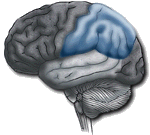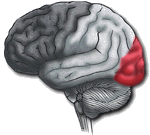Parietal Lobes and Occipital Lobes
Parietal Lobes and Occipital Lobes
The Parietal Lobe and the Occipital Lobe are the two remaining principal lobes of the brain. The parietal lobe is located behind the frontal lobes and above the temporal lobes and is shown as blue in this picture. The frontal lobes are a charcoal gray and the temporal lobes a light gray. The functions of the parietal lobe include the appreciation of touch, awareness of the position of the extremities, vibratory sense and the fine tactile perception. Thus, the sensory cortex is contained within the parietal lobes. The sensory cortex is contained in the most forward part of the parietal lobes. This is just behind the central sulcus (valley) which is the parietal lobes boundary with the frontal lobes. This sensory cortex is on what is called the post central gyrus (ridge).
Further to the rear in the parietal lobes are areas for the reception and organization of language functions. The parietal lobes integrate sensory data from other parts of the body. They also play a big role in understanding numbers and their relations. Further, they have an important role in the manipulation of objects and in the processing of information relating to the sense of touch.
The parietal lobes have both the left and right hemispheres. The left side is concerned in symbolic functions in language and mathematics. The right hemisphere is more focused on images and spatial relationships.
The Occipital Lobes are located behind and beneath the Parietal Lobes and to the rear of the Temporal Lobes. The Occipital Lobes are red in this picture. The occipital lobes contain the primary visual cortex. The Occipital Lobes are divided into different functional visual areas. Each area contains a map of the visual world. The Occipital Lobes are the area where specialized neurons which receive and process visual information reside. The visual pathways run from the retina to the primary visual cortex, contained within the Occipital Lobes. While the eye is the lens for light and images that we see, it is the Occipital Lobes, in conjunction with other areas of the cerebral cortex, that actually see. The energy of the light is recorded on the retina, then transmitted through neurons with direct connections to the Occipital Lobes, where the meaning of the light pattern, is interpreted. Thus, it is possible to have a completely normal eye, but be blind, because of damage to the occipital lobes. Thus the term, cortical blindness.
Next – Brainstem and Cerebellum





